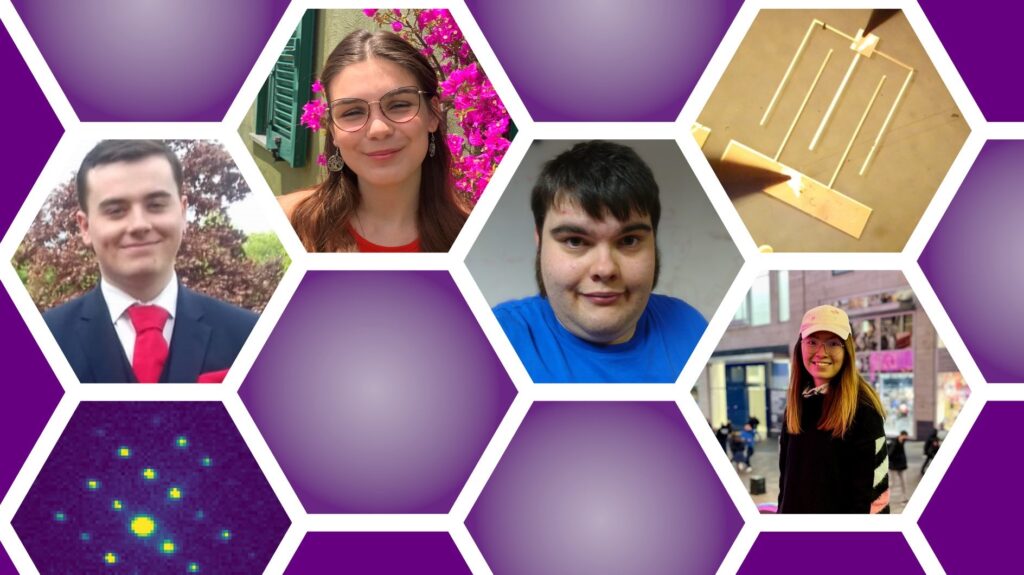Ross receives a prestigious Vacation Scholarship from the Carnegie Trust to sponsor his summer project in the GOOD group. Congratulations Ross!
Fabien receives Royal Society of Edinburgh research award
Fabien was one of the 37 researchers being awarded a Research Award from the Royal Society of Edinburgh.
Congratulations to SUPA’s @CCochard3 @UoD_physics and @FabienMassabuau @PhysicsStrath for winning RSE Small Research Grants ? https://t.co/3F6UglIy3v
— SUPA (@physicsscotland) July 4, 2022
The GOOD group at UK Semiconductor
The GOOD group travelled down to Sheffield for UK Semiconductor to present our latest research on Ga2O3. David was giving his first in-person presentation on the origin of the 3.8 eV luminescence line in Ga2O3, and Fabien was presenting his work on Ti contacts to Ga2O3. Fabien also gave a featured talk at the Ga2O3 Innovation Session on the opportunities and challenges of Ga2O3 devices.
Strong @semispecdev @PhysicsStrath representation at the #Ga2O3 session of UK Semiconductors.
— Fabien Massabuau (@FabienMassabuau) July 7, 2022
Here's Daniel smashing it with one of the world's first hyperspectral CL maps of SnGa2O3! pic.twitter.com/bwps72xS0U
Fabien receives Rank Prize Research Visionary Award
Fabien was down to London at the IET London: Savoy Place to share his vision for the future of UV optoelectronics and be presented the Rank Prize Research Visionary Award. The ceremony was hosted by science broadcaster Jim Al-Khalili.
Great honour to be handed a @rankprize Research Visionary Award for my vision on the future of UV optoelectronics.
— Fabien Massabuau (@FabienMassabuau) July 5, 2022
Thanks @rankprize and @jimalkhalili for an amazing and insightful ceremony! pic.twitter.com/7U20XSwdyz
Welcome to our summer students Ross, Aurora, Lewis and Aurora
Welcome to (from left to right) Ross, Aurora, Lewis, and Anthea into the GOOD group! They will be joining us for their summer projects.

Welcome Mugove
After a successful MSc project, Mugove Maruzane joined the GOOD group as a PhD student . In his PhD, Mugove will use the group’s EPMA to better understand Ga2O3 semiconductors, by combining optical, chemical and structural analysis of the materials.
Welcome Mugove!
Research Visionary Awards
Fabien receives a Research Visionary Award from the Rank Prize. He will take part in a tailored programme of workshops and one-to-one speaker and media training from Outsmart Insights to develop his vision on the future of UV optoelectronics.
Congratulations! Six ECRs in #nutrition / #optoelectronics will present their visions of the future to @jimalkhalili in January. @AngelaClaireW @plantsci @OfficialUoM @muneta_gmanzeke @UoNBiosciences @FionaMalcomson @HNRC_NclUni @FabienMassabuau @PhysicsStrath @OxfordPhysics pic.twitter.com/iDfGGA8fI3
— Rank Prize (@rankprize) November 4, 2021
2021 Emerging Leaders
Fabien appears in the list of Emerging Leaders issue of J. Phys. D: Appl. Phys.
@FabienMassabuau has been listed as a 2021 Emerging Leader in @JPhysD with a contribution on "Study of Ti contacts to corundum α-#Ga2O3"
— Physics, University of Strathclyde (@PhysicsStrath) July 12, 2021
Link to issue: https://t.co/2Vbr6hwHKq
Link to paper: https://t.co/Yg5u2zSRj1 pic.twitter.com/pXslkBBw3m
Welcome to Zak, Kay and Abrar
Warm welcome to Zak Johnston, Kay Polland and Abrar Almutari who are joining us for the summer.
– Zak will be working on UV-vis spectrophotometry of Ga2O3
– Kay will study Ga2O3 using temperature dependent photoluminescence
– Abrar will investigate the optical properties of h-BN using UV-vis spectrophotometry
PICO 2021: Sixth Conference on Frontiers of Aberration Corrected Electron Microscopy
Fabien has been presenting his new work on sequential plan-view TEM analysis of porous GaN at PICO2021.
Kick-off #PICOO2021 conference on Frontiers of Aberration Corrected Electron Microscopy.
— Fabien Massabuau (@FabienMassabuau) May 3, 2021
Join on Tue 10am (GMT) for my talk on sequential PV TEM. On the menu:
– Dislocations and pores
– Religious devotion to sample preparation
– Pretty pictures!https://t.co/xdcfcPXkpx pic.twitter.com/H2KY84ikCP


